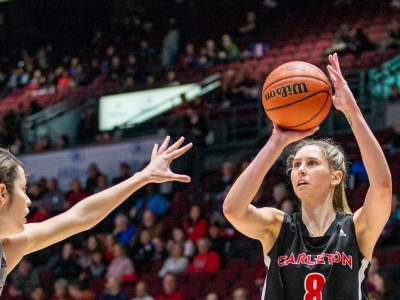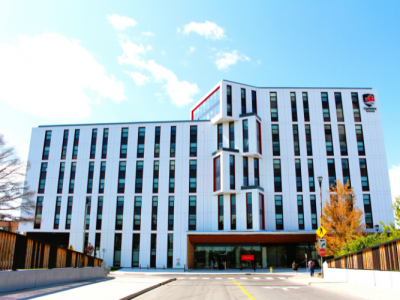By Joseph Mathieu
Photos by Josh Hotz
 To change the world, first change the definition of what is possible.
To change the world, first change the definition of what is possible.
Dozens of new definitions were found at the 40th annual School of Industrial Design Graduation Exhibition at the University Centre this year.
Ways to change the lives of elders, youth and the disadvantaged were dreamed up, thought out, and brought to life by fourth-year students and others who showcased their term projects and prototypes all themed under the banner of Beyond.
“We were looking for ways to describe Industrial Design in an inspiring way,” said instructor Sarah Dobbin, director of this year’s exhibition from April 21 to 23.
“Design enables us to go beyond the norm, to innovate, to think outside the box and improve people’s lives with that kind of thinking. Beyond encapsulates that.”
The School of Industrial Design regularly partners with local companies and organizations to broaden student horizons, and of the seven categories of projects, five were developed with the help and insight of partners.
Ben Kaufmann is part of a group of students called Cloud 9 who explored better ways for older adults to travel by air. As part of their research, the nine students were granted access to the NRC’s Canada Flight Research Laboratory at the Ottawa International Airport to test their products and systems.
He designed an aircraft seat that focused on stability in the cabin with handles behind the headrests. Bolted into the floor, the handles are sturdy and wouldn’t upset the person sitting in the seat. Throughout five testing phases, he observed older adults climbing in and out of aircraft seats, and even wore a geriatric suit himself to simulate the physical limitations of advanced age.
“Travelling around myself, I’ve realized how this is a problem, and because air turbulence is expected to rise over 300 per cent by 2050 because of climate change, I wanted to find a way to keep people stable and safe,” he said.
Other projects in Cloud 9 considered the challenges of the elderly or infirm in developing innovative ways to improve cabin mobility, ergonomics and task lighting, as well as simpler airport assistance, navigation and security screening.
“The hardest part was finding a real-world problem that hadn’t been solved or that we thought could be solved in a better way,” said Kaufmann. “The idea is to always frame it the way that helps more people, whether in incremental or very innovative ways.”
Four students worked with the Dovercourt Recreation Centre in Westboro to create devices for older adults to get exercise that incorporates music to improve dexterity, muscle strength and balance. One such project focused on cardiovascular health with a device called Jive. Seniors stand in a circle around the cylindrical music machine as it emanates colourful projections they can dance to, in the style of arcade game Dance Dance Revolution.
Working directly on challenges faced on campus, another group of students partnered with Carleton University Parking Services to address the rapidly changing field of transportation. Six projects explored a redesign for the Parking Services website, the development of an app, an adaptive electric vehicle charging station, and new ways to visualize available parking options on campus.
Alicia Stewart and Abdullah Usman worked closely with Being Studio, formerly known as H’Art Ottawa, to develop more accessible ways for disabled artists to mix paints, sit comfortably while they work, and clean their equipment. They visited the organization that supports visual artists and writers with developmental disabilities on a weekly basis.
Another group made regular visited to the brand new Canada Science and Technology Museum, partnering with Ingenium Museums to design an inclusive seating arrangement in the renovated museum’s central hub.
To push beyond the boundaries of active learning, several projects developed alternative designs and methods to help engage students. With insight and feedback from the university’s Educational Development Centre, students developed better services and innovative devices like a multi-disciplinary storytelling toolkit for recording and reporting in the field, and a school tablet that streamlines focus, time management and classroom communication while minimizing distractions.
The MetaWear group concocted wearable tech solutions for the 21st century workplace to accommodate the trend of more employees working remotely. Among their solutions were augmented reality and robotic avatars, as well as products and systems for non-verbal solutions, privacy, assistive focus, and stress management.
Alongside the 36 capstone projects were presentations from first- to third-year studio projects, award-winning minor studio projects, and a master’s degree project where three teams of grad students designed three visions of a MacOdrum Library Book Arts Lab.
“This has been a very exciting project in terms of encouraging community involvement, such as experts and artists in letter pressing, paper making, marbling, bookbinding, to develop design insights and directions,” said Prof. Çağla Doğan, who taught the course.
Besides many in-studio presentations, workshops, and interviews, the master’s students also took a field trip to the Robertson Davies Library at Massey College workshop, and conducted interviews and participatory design workshops with the Ottawa printing community. The results are incredibly detailed models of a laboratory focused on the Chandler and Price printing press, which has been in the Carleton library since 1988, and how it could once again become functional.
Wednesday, April 25, 2018 in Campus News
Share: Twitter, Facebook



